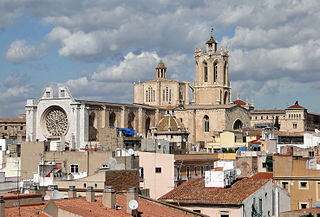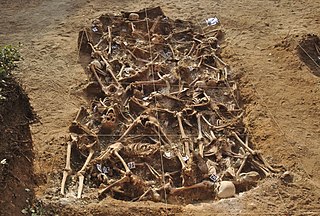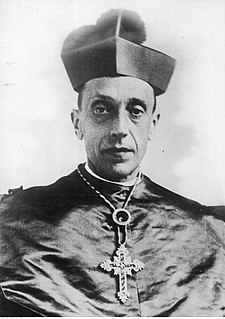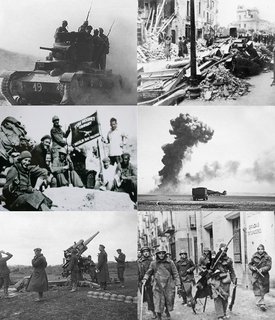Related Research Articles

Emilio Mola y Vidal, 1st Duke of Mola, Grandee of Spain was one of the three leaders of the Nationalist coup of July 1936, which started the Spanish Civil War.

The Archdiocese of Tarragona is a Roman Catholic ecclesiastical territory located in north-eastern Spain, in the province of Tarragona, part of the autonomous community of Catalonia. The archdiocese heads the ecclesiastical province of Tarragona, having Metropolitan authority over the suffragan dioceses of Girona, Lleida, Solsona, Tortosa, Urgell and Vic.

The cardinal electors in the 1939 papal conclave numbered 62 and all of them participated. They are arranged by region, and within each alphabetically.

Enrique Pla y Deniel was a Spanish cardinal of the Roman Catholic Church. He came from a rich Barcelona family and trained at the local seminary and the Gregorian University in Rome before an early career in journalism and seminary teaching. He took possession of the Salamancan see in 1935. "His seven years in Salamanca, from where he played a crucial role in the construction of General Franco's crusade, were rewarded with elevation to the primatial see of Toledo". He served as Archbishop of Toledo from 1941 until his death, and he was elevated to the cardinalate in 1946 by Pope Pius XII.
Manuel Arce y Ochotorena was a Spanish Cardinal of the Roman Catholic Church who served as Archbishop of Tarragona from 1944 until his death, and was elevated to the cardinalate in 1946 by Pope Pius XII.

The Red Terror in Spain is the name given by historians to various acts of violence committed from 1936 until the end of the Spanish Civil War by sections of nearly all the leftist groups. News of the rightist military uprising in July 1936 unleashed a politicidal response, and no Republican controlled region escaped systematic and anticlerical violence, although it was minimal in the Basque Country. The violence consisted of the killing of tens of thousands of people, attacks on the Spanish nobility, business owners, industrialists, and politicians and supporters of the conservative parties, as well as the desecration and burning of monasteries, convents, and churches.
The Martyrs of the Spanish Civil War are the Catholic Church's term for the people killed by Republicans during the Spanish Civil War for their faith. More than 6,800 clergy and religious were killed in the Red Terror. As of June 2022, 2,095 Spanish martyrs have been beatified; 11 of them being canonized. For some 2,000 additional martyrs, the beatification process is underway.

Isidro Gomá y Tomás was the Bishop of Tarazona in the province of Zaragoza known for his strong support of Francisco Franco and the National Movement during the Spanish Civil War from 1936 to 1939. He was also later made Cardinal and Archbishop of Toledo and was Primate of Spain. Gomá was an integrista, in the technical sense in believing in the necessity of a 'Confessional State' that imposes upon all its subjects the profession and practice of the Roman Catholic religion and prohibits all others.

In the history of Spain, the White Terror describes the political repression, including executions and rapes, which were carried out by the Nationalist faction during the Spanish Civil War (1936–1939), as well as during the first nine years of the regime of General Francisco Franco. In the 1936–1975 period, Francoist Spain had many official enemies: Loyalists to the Second Spanish Republic (1931–1939), Liberals, socialists of different stripes, Protestants, intellectuals, homosexuals, Freemasons, Romanis, Jews, and Basque, Catalan, Andalusian and Galician nationalists.

Lluís Martínez i Sistach is a Spanish prelate of the Catholic Church. He is Archbishop emeritus of Barcelona, having served as archbishop there from 2004 to 2015. He has been a cardinal since 2007.

Francisco de Asís Vidal y Barraquer was a Spanish Catalan cardinal of the Roman Catholic Church who served as Archbishop of Tarragona from 1919 until his death; he was elevated to the rank of cardinal in 1921.

The 498 Spanish Martyrs were victims of the Spanish Civil War beatified by the Roman Catholic Church in October 2007 by Pope Benedict XVI. They originated from many parts of Spain. Their ages ranged from 16 years to 78 years old. Although almost 500 persons, they are a small part of the Martyrs of the Spanish Civil War.

The Spanish Civil War was a civil war in Spain fought from 1936 to 1939 between the Republicans and the Nationalists. Republicans were loyal to the left-leaning Popular Front government of the Second Spanish Republic, and consisted of various socialist, communist, separatist, anarchist, and republican parties, some of which had opposed the government in the pre-war period. The opposing Nationalists were an alliance of Falangists, monarchists, conservatives, and traditionalists led by a military junta among whom General Francisco Franco quickly achieved a preponderant role. Due to the international political climate at the time, the war had many facets and was variously viewed as class struggle, a religious struggle, a struggle between dictatorship and republican democracy, between revolution and counterrevolution, and between fascism and communism. According to Claude Bowers, U.S. ambassador to Spain during the war, it was the "dress rehearsal" for World War II. The Nationalists won the war, which ended in early 1939, and ruled Spain until Franco's death in November 1975.
Barraquer is a surname. Notable people with the surname include:
Foreign relations between Pope Pius XI and Spain were very tense, especially because they occurred within the context of the Spanish Civil War and the period of troubles preceding it.

Catholicism in the Second Spanish Republic was an important area of dispute, and tensions between the Catholic hierarchy and the Republic were apparent from the beginning, eventually leading to the Catholic Church acting against the Republic and in collaboration with the dictatorship of Francisco Franco.

Manuel Carrasco i Formiguera, was a Spanish lawyer and Christian democrat Catalan nationalist politician. His execution, by order of Francisco Franco, provoked protests from Catholic journalists such as Joseph Ageorges, the President of the International Federation of Catholic Journalists. Ageorges wrote, "Even more than the death of the Duke of Enghien stained the memory of Napoleon, the death of Carrasco has stained the reputation of Franco". Such protests, in turn, provoked the anger of the Francoist press. His funeral in Paris on 27 April 1938 was attended by many notable people, including Joan Miró, Ossorio y Gallardo, Josep M. de Sagarra, Joaquim Ventalló and Jacques Maritain and his wife Raissa.

Manuel de Irujo Ollo was a lawyer and politician from Navarre, Spain, who became the leader of the Basque Nationalist Party during the Second Spanish Republic. He was a liberal democrat with a profound faith in Christianity. He was Minister of Justice in 1937 during the Spanish Civil War (1936–1939). He went into exile after the Republican defeat. He returned from exile in 1977 and was elected to the Senate.
Anarchism in Andorra peaked during the 1930s, when anarchist ideas were at the forefront of revolutionary politics in the Catalan countries.
Aileen von Vittinghof gennant Schell zu Schellenburg, was an American writer, journalist, and political activist. She was a devout Catholic and anti-communist. She is known for her 1938 lecture tour of the United States, where she advocated on behalf of the Nationalist faction of the Spanish Civil War.
References
- ↑ Chapter Six, The Collective letter , Gunpowder and Incense, Hilari Raguer, Routledge
- ↑ Raguer, p.145
- ↑ Raguer, p.112-113
- ↑ Raguer, p.115. Note:The martirologio of the diocesan archivist Josep Sanabre, referring to the situation in Barcelona, remarked that from September 1936 priests and religious generally received only prison sentences, and that after the events of May 1937, when the Anarchists lost power "it is indisputable that the assassinations of our companions, the priests, came to a stop" and the majority of the priests held in prison, were released.(Raguer, p.128) The writer George Orwell observed that in 1937 the Communists were responsible for imprisoning, not Fascists but revolutionaries [-]"Communism is now a counter-revolutionary force"; " the anticlerical movement, in its violent form, is a popular movement and a native Spanish movement. It has its roots not in Marx or Bakunin, but in the condition of the Spanish people themselves."
- ↑ Raguer, p. 115-116